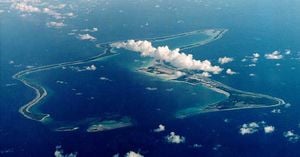The Middle East is once again thrust onto the global stage as tensions between Israel and Hezbollah escalate dramatically. This increased hostility follows the assassination of key leaders within both factions, most prominently, the targeting of Hezbollah's leader, Hassan Nasrallah, and the Hamas leader, Ismail Haniyeh. The backdrop of these events sets the scene for what is being described as one of the most significant flare-ups between Israel and Iranian-backed forces.
On October 1, 2024, Iran retaliated against Israel with what many analysts are calling its largest direct strike to date, launching ballistic missiles aimed at military bases within Israel. This assault came as Iranian leaders sought to restore their diminishing authority after years of perceived restraint following targeted killings and raids on its allies. According to analysts, Iran's decision to engage openly stems from both emotional and strategic motives. It was described as not merely revenge for the killings of Haniyeh and Nasrallah but also about restoring deterrence and signaling to allied militias across the region.
Prior to the recent attacks, the relationship between Iran and Hezbollah showcased the intricacies of middle-eastern alliances and rivalries, often blurring the lines between authorities of terrorist organizations and State actors. Following months of covert activities, Israeli Prime Minister Benjamin Netanyahu’s government escalated its operations against these groups, viewing the assassination of Nasrallah as both a tactical advantage and a show of strength.
According to The Conversation, this shift marks the departure from what has long been referred to as the “shadow war” between Israel and Iran—a struggle fought largely through proxies and clandestine operations. October’s events showcased the evolution of the conflict, illustrating how sharp as the lines have become, leading to direct confrontations and military strategies involving heavy bombardments.
The deaths of senior military figures and the extensive missile launches highlight the vast technological advancements made by Israel. They possess sophisticated aerial defense systems, which they used to intercept many of the Iranian missiles. Reports suggest most of the attacks were neutralized; nonetheless, Iran maintained its claim of having inflicted significant casualties—a claim disputed by Israeli officials.
The Israeli military's determination to eliminate key Hezbollah leaders has resulted not only from intelligence gathering but from systematic strikes aimed at paralyzing the operational capabilities of the group. This newfound aggression arose significantly after the perceived weakening of Hamas following their leadership's decimation. Hezbollah, already dealing with internal challenges, found itself on the back foot, battling to maintain influence and relevance as its leaders were targeted one by one.
Notably, Hamas’ capabilities were severely curtailed following the bombings, prompting Israeli officials to announce their readiness to confront Hezbollah directly. This recognition of familial ties—both diplomatically and militarily—between Hamas and Hezbollah fuels the complexity of the conflict. Hezbollah’s embattled status is compounded by the recent assassination of Nasrallah's cousin, Hashem Safieddine, who held significant sway within the organization. The targeting of such high-ranking officials captures the essence of both Israeli strategy and Iranian motivations to retaliate.
With the Israel Defense Forces (IDF) issuing immediate evacuation orders to villages along the southern border, civilians bear the brunt of these military strategies. The Guardian reported significant disruptions, with reports of more than 300,000 people fleeing their homes due to the onslaught of airstrikes aimed at Hezbollah strongholds.
Public reaction within Lebanon remains mixed. Some view the resilience of groups like Hezbollah as integral to national pride, particularly when especially aggressive Israeli tactics are employed against their positions. Others fear the excesses of retaliation could lead to full-scale warfare across borders, thrusting Lebanon back to the brink of devastation. Reports from the ground depict civilians caught between military expeditions and the political maneuvering of powerful entities far beyond their influence.
Despite voices of dissent against the Iranian leadership for delayed response to Israeli assaults, such criticism is often tempered by widespread support for retaliatory actions aiming to re-establish deterrence. The Iranian narrative frames Israel as the aggressor, warranting responses aimed not only at revenge but also realigning geopolitical stakes.
Experts are wary of the unpredictability present within the dynamics of this conflict, noting historical precedents where decapitation strikes against militant leaders often lead to intensified fervor, as successor leaders tend to take more radical and unyielding approaches—which may, paradoxically, dilute stability. These sentiments are echoed by diplomats who posit the possibility of Israel’s actions inadvertently prodding Iran and its allies to reinforce their commitments to its proxies, leading to spiraling tensions.
Hezbollah, having lost several key leaders over the past few weeks, received little respite from the barrage of Israeli operations. The interplay of attacks highlighted the fragile nature of power within these organizations. Political analysts maintain Hezbollah has mechanisms to recover from adversities, yet their ability to rebound will depend on internal factors and how effectively they are shielded from external pressures.
Importantly, as Iran prepares for potential escalated military responses, they threaten severe repercussions should Israel’s operations continue unopposed. U.S. and Israeli officials are locked in discussions exploring contingencies to stem the tide of warfare, all the more pressing with absurd calculations over how war could ripple across the region.
With analysis pointing to unresolved tensions and the likelihood of mutual escalatory actions, many question how these actions will impact the broader strategic framework across the Middle East. Observers are bracing for possibilities, reckoning with historical observations indicating region-wide conflict escalation hardly remains exclusive to localized frictions.
Moving forward, the situation remains dire, exemplifying how quickly geopolitics can pivot from restrained backchannel negotiations to widespread hostility as factions both assert their influences and cunningly navigate through treacherous waters. Analysis reflects sentiments from all corners, urging for caution whilst recognizing the volatility ingrained within these longstanding rivalries.



